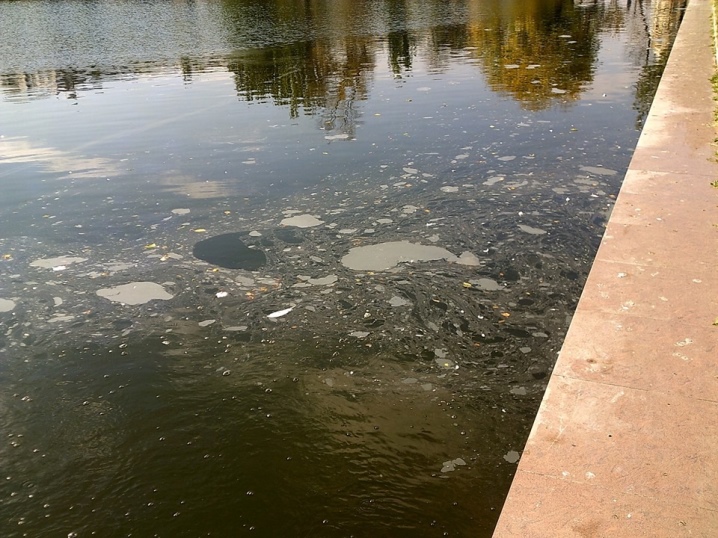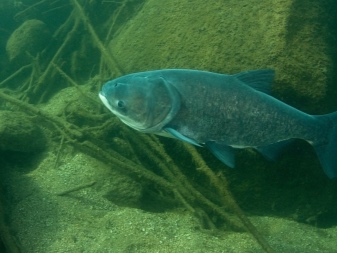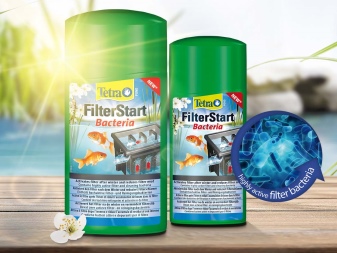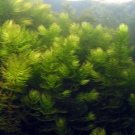Water treatment methods

Any artificial reservoir sooner or later becomes polluted - the bottom is silted up, and the water becomes cloudy. In order not to pay for the expensive services of specialists, many try to do the cleaning with their own hands. How to do this - we will tell about this in our review.
The need for a procedure
An artificial pond is usually located on the territory of a summer cottage in the open air. That is why it is exposed to pollution of natural and mechanical origin. Among the main sources of pollution are:
- blown by the wind leaves, small and large branches;
- small bio-waste - insects, microorganisms and their waste;
- large bio-waste - earthworms, creepers and even rodents.

There can be many reasons for water pollution in a summer cottage. The most common are:
- excessive number of microorganisms living at the bottom of the pond - the active activity of bacteria and fungi leads to a decrease in oxygen in the water column, this stimulates the active growth and flowering of duckweed and causes an oily film to appear on the surface;
- accumulation of waste products of fish and aquatic animals in the water, as well as substances resulting from the decay of plants, this leads to the appearance of mud, the water in such a reservoir is heated unevenly and this enhances the appearance of pathogenic microflora.

It is quite problematic to protect a reservoir in the country from sources of pollution. That is why from time to time you have to resort to measures to cleanse it.
Determination of the degree of pollution
Certain changes may become the reason for the cleaning work.
- Loss of water transparency and discoloration. This may indicate the onset of eutrophication, or it may indicate that large amounts of inorganic suspensions have entered the pond, usually sand, earth, or clay. The change in the color of the reservoir is also associated with the vital activity of microorganisms, which began to develop actively due to the large volume of organic matter accumulated at the bottom.
- Overgrowth of the pond with plants. This happens when muddy deposits form on the bottom. As a result, the artificial reservoir becomes shallow and heats up quickly.
- The appearance of a rotten smell... It is a consequence of the activity of fungi and bacteria, the colony of which has increased dramatically.


Usually, these three symptoms are enough to effectively cleanse a garden pond of everything that makes it not an aesthetic piece of nature, but an ordinary pit with dirty water. The choice of treatment technique for a reservoir directly depends on the degree of its pollution.
There are four main stages of pollution.
- The first - the reservoir is littered with plant debris (fragments of plant stems, branches, leaves, fluff or pollen).
- The second - the surface of the pond begins to exude a strong rotten smell and is covered with a thin oily film.
- Third - vegetation spreads in the water, it can be blue-green algae, duckweed or cattail.
- Fourth - the most serious. Excessive gas formation in the water column. This usually happens if sewage has fallen into the artificial pond.
Overview of mechanical methods
Mechanical purification of a reservoir involves the use of the simplest filters.They let water pass through themselves, retaining all particles of debris, algae, grass and large plankton.

Manual cleaning
The manual method of cleaning the reservoir is effective only at the first stage, when large fragments of plant residues of different sizes must be removed from the water. In all other cases, the work is laborious and ineffective at the same time. Manual cleaning is considered solely as professional measure... Periodic manual filtration of water in an artificial pond prevents the problem, but does not eliminate it in any way.
To carry out cleaning, you will need a net, a basin, as well as a fan rake and a "cat" device. A net, a rake and a cat from the surface of the pond carefully collects all the garbage with duckweed and is thrown into a bucket.

The disadvantage of this work is that it allows you to clean exclusively the surface layers of water, while the depth is not affected.
Water vacuum cleaner
The use of a water vacuum cleaner-sludge suction will be more effective. You can buy such a device in any specialized store and, if desired, make it yourself. Such a device works on the mechanism of a vacuum cleaner - it sucks in all the contaminated liquid, filters it thoroughly, and then returns it to the reservoir.

However, the scope of such equipment is limited. The device cannot be used in lakes inhabited by frogs or fish. Otherwise, electrical equipment will destroy a significant proportion of tadpoles and fry.

Skimmer
Another electrical device that helps to perform effective cleaning is a skimmer (dredger). To cleanse an overgrown reservoir, special traps are placed in its most polluted area. They are connected by means of a flexible hose to a powerful pump located on land.

The dredger sucks in liquid for purification, water passes through filters, gets rid of growing organisms, and then returns back.
This method does not require a significant investment of time and effort. However, it does not allow cleaning the bottom of the pond and the bottom.... The disadvantages of the equipment also include the need to connect it to the mains. Typically, such techniques are used in small artificial ponds, where larger equipment simply does not fit.

Description of chemical methods
A good alternative to mechanical methods of water purification in summer cottages is the periodic use of chemical reagents. They have a positive effect on fluid quality and composition. Most of the chemicals on sale are absolutely safe for the pond ecosystem, they do not cause any harm to fish and growing grasses.

The use of chemicals solves several important tasks at once:
- cleans the pond from harmful microorganisms, removes overgrown algae;
- normalizes acidity levels;
- reduces the volume of emissions of hydrogen sulfide and methane;
- clarifies water, increases its transparency;
- produces a general cleaning of water and saturates it with oxygen.

For effective cleaning, it is better to give preference to reliable drugs. Experienced summer residents usually use quality mixtures from the manufacturers Sera and Heissner.


Important. When treating water, you must strictly adhere to the manufacturer's instructions. An overdose of chemicals can damage not only the flora and fauna of the pond, but also coastal vegetation and even people in case of contact with such water.
Sorption purification gives a good effect.... It involves the use of zeolites or other porous minerals. These substances make it possible to remove ammonium and phosphorus from water in the shortest possible time.
For cleaning, sorbents are placed in flow filters or simply scattered over the silted bottom at the rate of 1 kg per 1,000 liters of water. This volume is sufficient to maintain the transparency and purity of the ecosystem for 1 year.
It is possible to rid water of parasites, pathogenic bacteria, accelerate the decomposition of organic matter and increase the oxygen concentration with lime - both extinguished and quicklays will do. The choice of a product directly depends on the method of application, the structure of bottom sediments, the level of acidity of the soil and water. So, for the treatment of a small summer cottage, quicklime is used at the rate of 1 kg / m3. Slaked lime will need 1.3 times more, and ground limestone - 1.8 times.

Liming can be used as a preventive measure. To do this, during May and the first half of June, quicklime is added to the water every 10-14 days at a rate of 100 g / m3.
Gives a good effect use of hydrogen peroxide.

Biological methods
Biological cleaning techniques combine high efficiency and safety for the artificial lake ecosystem. These methods can help reduce the volume of algae and other aquatic organisms. The required effect is achieved through the creation of bioplato or the use of biological products.
Bioplato
To create a bioplato next to an artificial pond or just above it, you need to dig a pit, and then populate it with valuable algae and crustaceans. They create a powerful self-cleaning system. Cleaning a reservoir using this technique involves several steps.
- The contents of the main pond through an electric pump in small portions enter the bioplato.
- Crustaceans and overgrown algae purify the water.
- Purified water flows back into the reservoir by gravity along the filter embankment from crushed stone.
- The treatment process is repeated until the water is completely purified.

A good effect is provided by the use of phytophages, that is, fish that purify artificial and natural reservoirs. The most famous of these are the grass carp and silver carp. The mass of plant residues eaten by them corresponds to the weight of the fish, and sometimes even exceeds it. It is this feature that makes it possible to ensure high efficiency of water treatment.
Such fish are not too pretentious about the environment in which they live. They can be kept separately in a bioplato, or they can be added to carp ponds. They are resistant to infectious diseases, tolerate temperature fluctuations well, and their maintenance costs are low. However, it must be borne in mind that these cleaners absorb not only polluting plant residues, but also all the vegetation of the artificial pond.


This can cause serious damage to the ecosystem, so their number should be limited.
Bacterial drugs
Against the silting up of the pond, you can use special biological products that saturate the pond with beneficial microorganisms. These bacteria have the ability to recycle the remains of aquatic life and plants, as well as spores. Their activity neutralizes pathogenic microflora, cleans the reservoir of decaying plankton, removes hydrogen sulfide and normalizes the acidity of the water.
In order for the cleaning to be effective, it is best to use drugs JBL FilterStart Pond, Starter-Bacterien, Algenkiller, as well as Aqua Balance, Prudochist and others. They start working from the first minutes - they destroy toxic nitrogen compounds, decompose bottom sludge, inhibit photosynthesis and thereby destroy blue-green algae.




All products are available in liquid or powder form. The validity period corresponds to 4-6 weeks.
The advantages of such biological products include high efficiency, speed of action and safety. However, there are also disadvantages. This is a change in the composition of the water. The use of biological products requires the parallel use of reagents that reduce the level of methane and enrich the water with oxygen. Considering that such drugs are expensive, general cleaning work will cost a tidy sum.

Other options
One of the most effective ways to neutralize sludge accumulated at the bottom of the reservoir is exposure to ultraviolet radiation.... To do this, use special devices with lighting elements mounted in it. They are placed directly into water and activated by ultraviolet radiation. It quickly destroys bacteria and some types of viruses.

The advantages of this method are the absence of chemicals and a gentle effect on the biosystem. However, it can only be used in a cloudy liquid, it does not get rid of leaves and debris.

If the reservoir is heavily polluted, you must first clean it from large plant residues mechanically, and then activate the ultraviolet emitter.
If none of the above methods helped, it makes sense to resort to a complete water change. Experts advise to renew the water in the pond at least once a year, and preferably twice. This should be done even if powerful filters do the job to the fullest. The water renewal scheme will help to cope with the task.
- First you need to drain all the liquid from the artificial reservoir. If fish, frogs or tadpoles live in it, they should first be deposited in an aquarium or any other container. The aquatic plants are transferred to a plastic bowl.
- The surface of the reservoir cleaned from mud and debris mechanically.
- The reservoir is filled with fresh water and its inhabitants are returned back.... Most likely, the contents of the pool will immediately become covered with turbidity - this is due to the active work of microorganisms that inhabit the new environment. But do not worry, after a couple of days the water will return its transparency again.

Pond Care Tips
Keep in mind - if you study the pond once a year, and the rest of the time you do not pay attention to changes in the water, then it will retain its aesthetic appearance for a very short time. Maintenance of an artificial reservoir should be regular, it is important not to let it become too dirty. A good help will be the purchase of an aerator, it ensures the saturation of water with oxygen. As a result, the microorganisms function correctly.

There are three types of aerators.
- Donny - this aerator is installed at the bottom of the pond and is responsible for oxygenation of the water column. The device prevents siltation and maintains the purity of the water. But it is very expensive, so in practice it is rarely used.
- Injector - the principle of operation of such a device consists in drawing in air and further mixing it with water. The device effectively oxygenates the water, but it is very noisy and consumes a lot of electricity.
- Surface - it creates a fountain of splashes and scatters them over the surface of the reservoir. This is a simple type of equipment, and its maintenance costs are low. From the outside, it looks like a fountain and can be a decoration for any garden lake.



It is very important to regularly deal with duckweed. If you do not pay enough attention to this, then in the shortest possible time it will fill the entire garden reservoir and make it look like a swamp. Floating plants can help - they also need oxygen with useful substances, so they will win part of the reservoir from the duckweed.


You should not populate an artificial pond with representatives of flora and fauna taken in their natural environment - with a high degree of probability they will bring duckweed with them.
If a small lake is occupied by reeds, do not even try to deal with it manually. The roots of the plant will still remain in the ground and will sprout again. You can get rid of such a neighborhood only with the help of an excavator.


To maintain the self-cleaning of the summer cottage lake, plants such as nymphea, elodea, fontinalis, arrowhead, calamus, hornwort, as well as marsh iris or cattail can be planted in the coastal zone.





A good effect is given by the settlement of the reservoir with daphnia or snails. Experienced summer residents keep a mesh bag with peat tablets or sphagnum moss in the water.From time to time, it is recommended to lower a bunch of willow twigs, cleaned of foliage, into the water.
































































The comment was sent successfully.